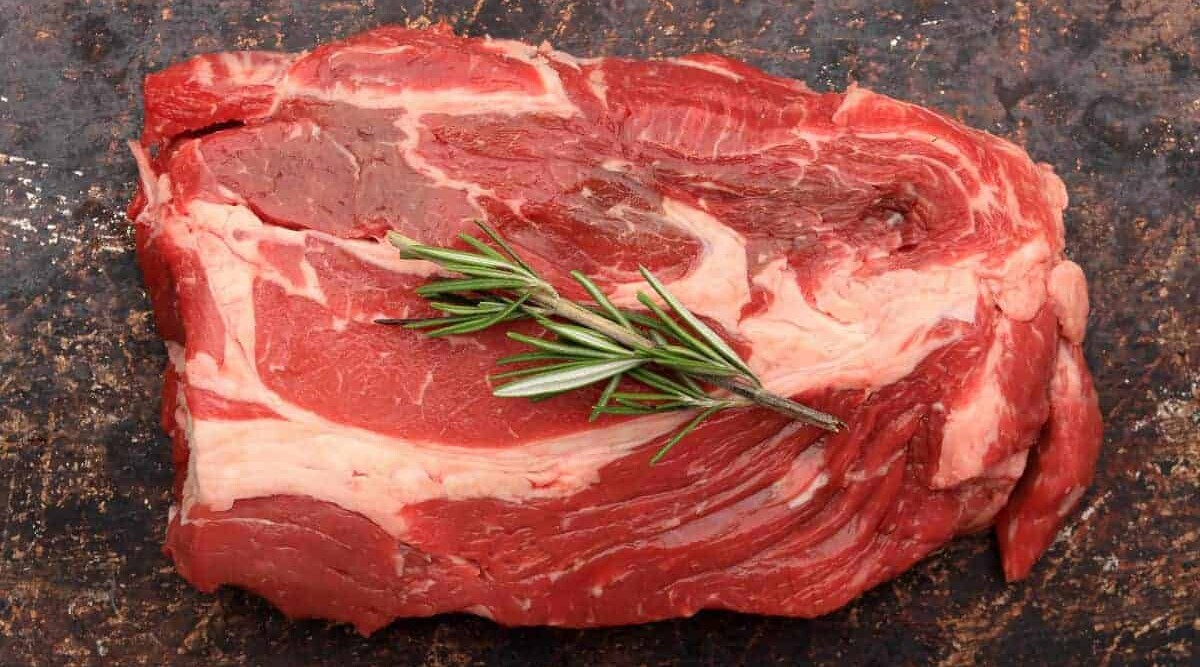
A blade chuck steak is a flavorful and affordable cut of beef from the shoulder area, known for its richness and tenderness when cooked slowly.
The chuck primal is well known for all those tough meat cuts that produce excellent flavor when cooked slowly. You’ve probably heard of the Chuck Tender roast or the Chuck Tender steak, but you may not have heard of the beefy heavyweight that is the blade chuck steak.
This cut is easily recognizable for its thick strip of interconnective tissue that runs through the middle. It takes a little more effort to understand and prepare, than say a Flat Iron steak from the same primal, but believe us when we say it’s worth it.
In this article, we discuss what blade chuck steak is, why it’s so great, where you can find it, how to prepare it, and how to cook it to perfection. Not only will your meat cut knowledge become next level, but you’ll also now have a cut of meat that is versatile, cheap, and full of flavor to add to your BBQ repertoire.
And if this sounds interesting, you should probably also check out our beef cuts diagram and guide.
Key Takeaways
- Blade chuck steak is a versatile, flavorful, and affordable cut of meat that is worth trying.
- It comes from the chuck primal near the shoulder blade of the cow and is a piece of meat that encompasses multiple muscles.
- The blade chuck steak has a thick strip of interconnective tissue running through the middle and has extensive marbling.
- The blade chuck steak has a rich beefy flavor with a wide grain, coarse, buttery texture.
- Blade chuck steak is also known as boneless blade steak, and deluxe blade steak.
- It can be used in various ways, such as being grilled as a standalone steak or divided into sections for stews, fajitas, or stir-fries.
- Blade chuck steak is readily available and comparatively cheap at most butchers and you can also purchase it online.
- When preparing and cooking blade chuck steak, it’s recommended to leave the fat seam in for added flavor and to cook it on high heat for a good sear.
- Overall, blade chuck steak is an excellent option for those looking for a flavorful and affordable cut of beef with versatility in cooking.
Jump to:
- 1 Key Takeaways
- 2 What is Blade Chuck Steak?
- 3 Where Does Blade Chuck Steak Come from on the Cow?
- 4 Other Names for the Blade Chuck Steak
- 5 Flavor, Texture, Fat Content And Tenderness
- 6 Typical Uses
- 7 Blade Chuck Steak Nutrition
- 8 Buying Blade Chuck Steak
- 9 Blade Chuck Steak Price
- 10 Portion Size: How Much Blade Chuck Steak Per Person?
- 11 My Personal Experiences With Bavette Steak
- 12 How to Prepare Blade Chuck Steak for Grilling or Smoking
- 13 How to Cook Blade Chuck Steak on a Grill or Smoker
- 14 Conclusion
What is Blade Chuck Steak?
With the name of this cut, we get a bit of a clue as to where it comes from. It comes from the chuck primal near to the … drumroll, please … Blade!
It’s a piece of meat that encompasses multiple muscles. It’s a big steak of similar appearance to the T-bone, weighing in at 12 to 16oz with a thick piece of fat in the center.
It can sometimes look like several pieces of muscle joined by fat, or it can be more uniform with just marbling and the central fat channel on show.
Where Does Blade Chuck Steak Come from on the Cow?

Blade chuck steak comes from the chuck primal of the cow, which is the large section of meat around the shoulder area. It’s made up of many intersecting muscles, which means lots of interconnective tissue and fatty marbling throughout.
The shoulder area also gets a lot of exercise which usually creates tough pieces of meat. However, some parts are much more tender, those that come from the top blade and surrounding areas, such as Denver steak, and our topic for today, the blade chuck steak.
If you take note of the intersecting muscles and change of grain throughout, it will help you to understand the best way to cook it.
The different types of Chuck steak are determined by the cut and position in the chuck primal, as well as the amount of cartilage within the meat, which in turn will affect the tenderness of the steak.
Other Names for the Blade Chuck Steak
Two common alternative names for blade chuck steak are:
- Boneless Blade steak — So called because you can get a Blade steak with the bone left in that can add to the flavor. The blade chuck is traditionally cut without the bone attached.
- Deluxe Blade steak — This name refers to the size of the steak and that it’s deluxe due to its tenderness compared to other chuck and blade cut steaks.
The blade chuck steak is one of those cuts that can be confused easily with similar cuts. There are many Chuck steak and Blade steak derivatives around, but the blade chuck is easily recognizable for its thick fatty seam through the middle.
Whichever name you use, if you have difficulty finding it, you can always use the industry ID: UPC–1066, 1073. Your butcher can use this to find it and give you tips on how to cook it.
Flavor, Texture, Fat Content And Tenderness
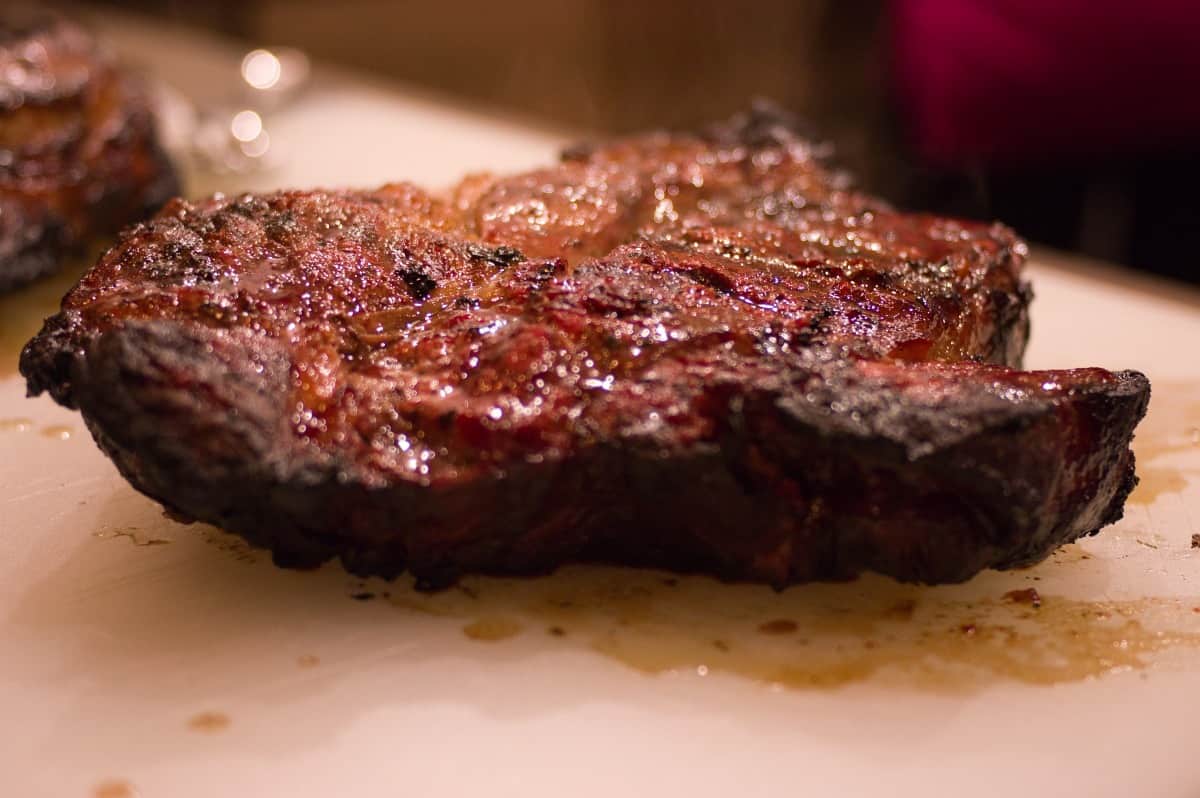
The blade chuck steak has one aspect that everyone loves, and that is flavor. The extensive marbling throughout coupled with the fatty seam means that this steak self-bastes and has a rich beefy flavor with a wide grain, course, buttery texture.
It won’t match a Fillet or Porterhouse for tenderness, but it will deliver great taste and texture well above its pay grade.
If you aren’t a fan of fatty steaks, we would recommend cooking with the fat seam in and then separating it and removing it before plating it up.
Typical Uses
The blade chuck steak has many uses in cooking. It’s made up of several connected muscles which can be divided into sections and used for stews or fajitas or stir-fry.
It also stands up well to be a good meaty standalone steak. So, versatility is this steak’s middle name.
Blade Chuck Steak Nutrition
| Nutrition | Total Amount (Based on 3 oz Serving) | % Daily Value (based on 2000 calories/day) |
|---|---|---|
| Calories | 210 | 11% |
| Saturated Fat | 4.3 g | 23% |
| Sodium | 60 mg | 2.5% |
| Protein | 26 g | 52% |
| Iron | 3.1 mg | 15% |
| Zinc | 8.6 mg | 60% |
Buying Blade Chuck Steak
Blade chuck steak is readily available from most supermarkets and online meat markets. Just be sure to compare it to the picture on meat master websites such as ‘beef it’s what’s for dinner,’ and that way you’ll have no problem tracking it down.
The blade chuck steak can often be found under different names depending on what the meat manufacturer decides to label it as, or whether the butcher has the specific knowledge to identify it as the correct cut.
Buying steaks online can remove the hassle of finding the right cut, particularly for those more unknown and tricky to identify ones such as this. They will show you multiple cuts with pictures, so you can see exactly what you’re getting.
Where to Buy Blade Chuck Steak Online
As mentioned, online food shopping can be enjoyable and stress-free for the grill enthusiast, by allowing you to take time to explore new cuts and different cooking methods in the comfort of your own home.
Once decided, you simply place your order and wait for the delivery, leaving you more time come BBQ day to spend with your grill beer in hand.
Here is an online outlet that sells some of the best blade chuck steaks available:
Blade Chuck Steak Price
It’s still a very cheap cut of meat, and at the time of writing, the price is $9 to $16 per lb. Across online outlets.
Portion Size: How Much Blade Chuck Steak Per Person?
Blade chuck steak comes in various weights from 8 to 16oz, so how much of it you serve up will be dependent on what you serve it with and who is going to be eating.
If you want the side to be big and bold, and to shine as much as the steak, then an 8oz steak will be perfect. If you have big eaters and want the meat to be the star of the show, then a 14 to 16oz steak is sure to impress.
My Personal Experiences With Bavette Steak
I first tried blade chuck steak five or so years back, simply seasoned with salt and pepper, then grilled at high heat for a sear before cooking through at a lower heat to medium rare. It blew me away with its rich flavor and tenderness.
The big seam of fat and interconnective tissue running through the middle didn’t render out properly with this cooking method, so I had to cut around and not eat that part. I’m happy to do this, but others may not be so keen.
More recently, I have this cut for ‘poor man’s burnt ends.’ This is more typically done with a chuck roast, but a nice thick blade chuck steak works really well for this dish, with the interconnective tissues a bonus instead of a hindrance. The long, low and slow cooking renders it out fully, and you get that drool-worthy fatty tenderness that burnt ends benefit from.
Blade chuck steak is also more affordable than many other cuts, so I use it semi-regularly instead of brisket for burnt ends. A similar result for way less cost. What’s not to like?
How to Prepare Blade Chuck Steak for Grilling or Smoking
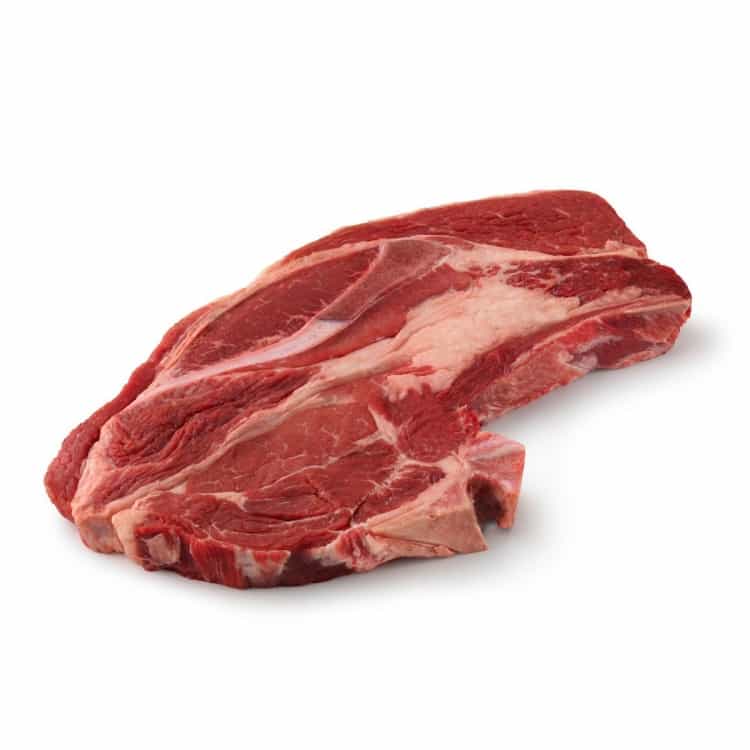
Blade chuck steak comes ready to go without any further preparation or trimming if you like all the fatty marbled goodness. If, however, you wish to make it less fatty, you can trim out some interconnective tissue, or even the fat seam in the middle. But you have been warned, this will affect the flavor.
If a blade chuck steak has a fat seam around the edge, I like to score it or cut through it in a couple of places to stop the steak from curling when it cooks.
Other than that, just a simple seasoning and a rub with some marinade if you so choose will be more than enough before cooking it on the grill.
How to Cook Blade Chuck Steak on a Grill or Smoker
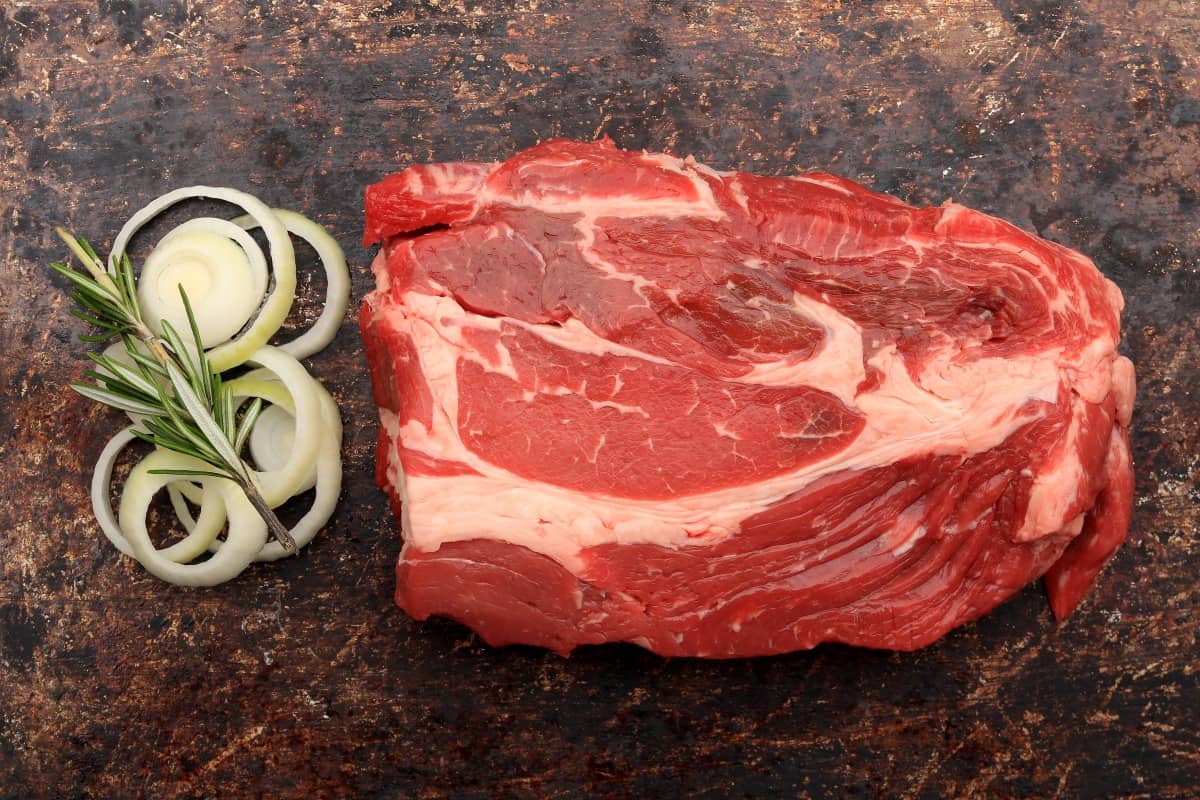
We recommend cooking blade chuck steak as a standalone steak before using it for any other type of recipe. That way, you can truly get a feel for the tenderness and flavor you get from this cheaper cut and appreciate how much bang you get for your buck.
The high-and-dry method we’ve spoken of before is the best way to cook this fabulous cut on a grill. Here’s our simple guide:
- Remove the steaks from the fridge and pat them dry.
- Heat your grill to maximum. This ensures a good sear and flavorful Maillard crust.
- Season well and place the steaks onto the grill.
- Cook for 3 to 5 minutes each side until close to medium, 130f internal, being careful not to overcook as it will be very chewy, and you’ll ruin it.
- Once at the correct temperature remove from the grill, it will continue to cook for a few minutes after.
- Allow to rest for at least 10 minutes, so the meat relaxes and redistributes juices that have been squeezed up while cooling.
- Slap it on your plate and savor the flavor!
Conclusion
The blade chuck steak is an all-rounder. Great flavor, endless versatility, and great value for money. It delivers a real beefy smack in the face for those that love a strongly flavored steak. It’s tender enough for the fussiest of steak eaters and can be served as a fat-filled indulgence, or trimmed to produce leaner pieces of meat that can be enjoyed with any type of side.
It can also be sliced up for things such as stir-fry and fajitas, or anything else you can think of. It will take whatever you decide to throw at it and deliver in heaps of flavor and juicy tenderness. So, go and get some ordered and report back to us how you get on.
Is it amazing? Are you sorely disappointed? Or is it the fantastic all-rounder you’ve been looking for to fulfill all your steak needs and yearnings? Let us know in the comments below.


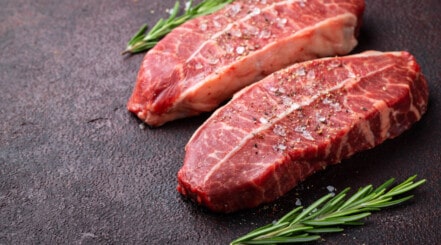


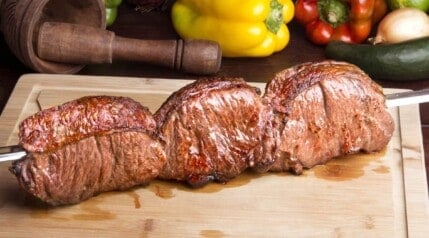
got one from kroger in apr 2023. got my small grill to near 450 f with just a couple minutes of high temp cooking on each side of this thin steak. tender, easy to cut and packed with flavor and 1.2 lbs was several dollars less than strip or ribye with to me equivalent flavor.